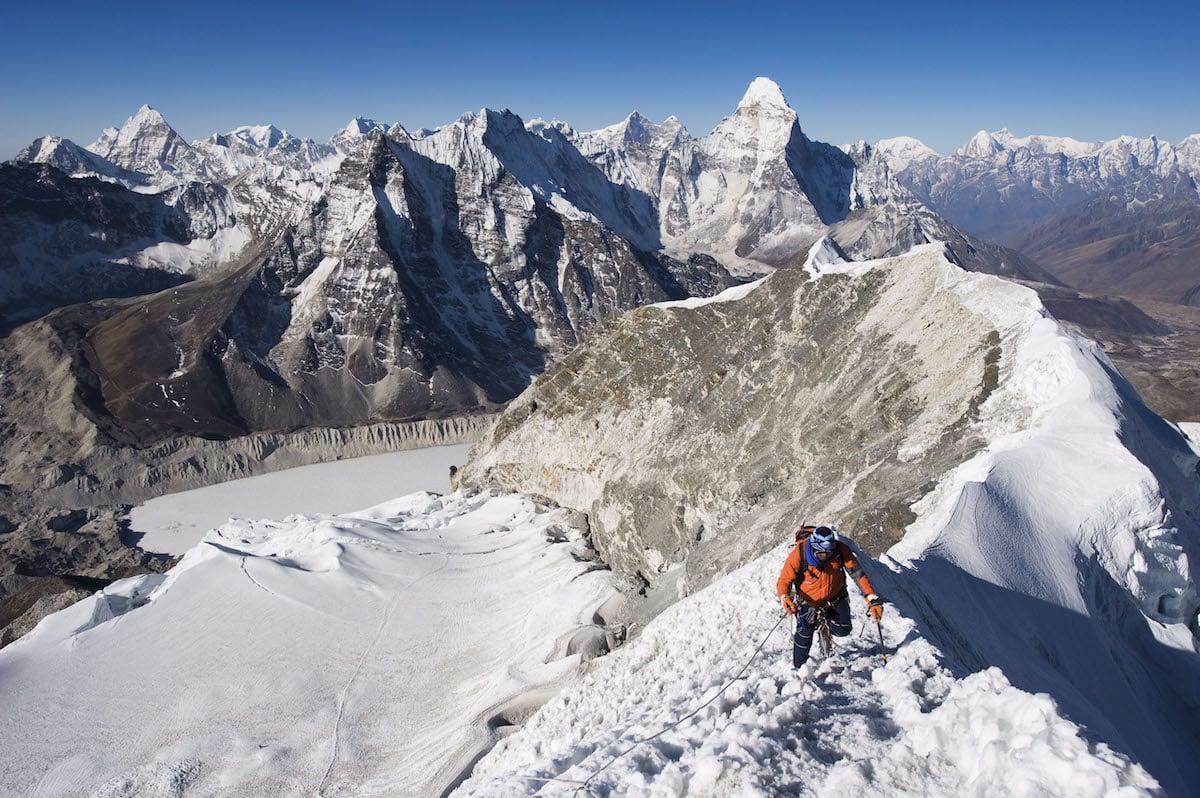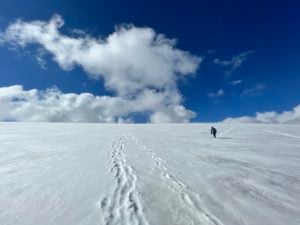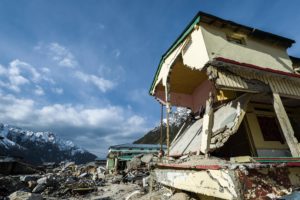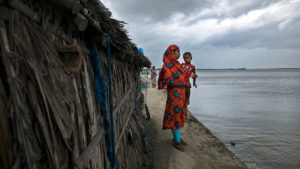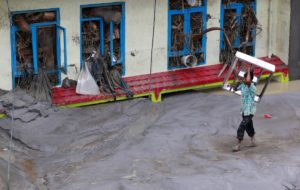In late winter 2020, glaciologist Sudip Thakuri visited Kalinchowk, a peak in the Himalayas around 144 km west of Kathmandu. He was surprised by what he saw. The destination, popular among Kathmandu residents seeking a sight of snow-covered mountains, wasn’t as thickly blanketed in white as in previous years. Later that winter he visited Nepal’s Makalu-Barun region, located southwest of the Everest area. Thakuri, who is dean of the faculty of science and technology at Mid-West University in Nepal, noticed a similar lack of snow.
According to recent observations published in the journal Remote Sensing, the first, second and third warmest winter days in 72 years in Nepal’s Everest region were recorded in the winter of 2020/21.
“We find that the January 10-15, 2021 period fell in the top 1% of all winter days since 1950 and this appears exceptional when viewed in a multi-decadal context,” said Prajjwal Panday, one of the members of the research team. The researchers used historical observations and data modelling (known as ‘reanalysis’) to estimate winter temperatures in the region between 1950 and 2018, and real-time data for the years after 2019, when weather stations were installed.
Reanalysis is a scientific method for developing a record of how the weather and climate are changing over time. Reanalysis data provides “the most complete picture currently possible of past weather and climate”, according to the European Centre for Medium-Range Weather Forecasts, using past observations and modern weather forecasting models.
Unusually warm winter
On 12 January, the maximum daily temperature recorded at Everest Base Camp was 4.9 degrees Celsius. The next day it reached 7.1C, and on 14 January it was recorded at 6.3C. The reanalysis data showed that the highest temperature for the 1950–2018 period was recorded on 11 January, 2018 (4.6C). From 9-22 January 2021, the maximum temperature at Everest Base Camp exceeded 0C on eight of the days. Normally temperatures here are well below freezing during the winter.
Unusually warm winters in the Everest region may have many implications for the geologically fragile area, including its glaciers. The team decided to investigate this, using a combination of real-time, reanalysis and satellite data. This allowed the researchers to examine and contextualise the impact of the exceptional warm conditions during the 2020 post-monsoon period through to the winter on glaciers in the Everest region
Glaciers in the Everest area such as Barun, Bhote Koshi and Hunku Nup are ‘summer-accumulation’ glaciers. This means that the bulk of the precipitation they receive, in the form of rain, ice and snow, falls during the South Asian monsoon between July and September. Below-freezing temperatures mean this precipitation is stored on the glacier. But during this period they also lose some mass, as temperatures are much warmer than those during winter – leading to melting of snow and ice.
When the monsoon stops around October and winter sets in, the glaciers stop melting. The snowline remains roughly constant until the warmer season starts, between February and March. This has been the traditional understanding of how glaciers accumulate and lose mass in the Everest region.
But the study suggests that this may be changing.
Spring conditions in depth of winter
The researchers used satellite images to assess the snowline on six glaciers and the ratio of snow to ice on two glaciers. More snow than ice indicates the glacier is melting slowly, whereas more ice than snow means faster melting is happening.
They found that the average elevation of the snowlines rose. The snow-covered areas declined by 5% and 11% between 13 October, 2020 and 22 January, 2021. This, according to the authors of the study, indicates that the melting of the glaciers may have continued well into winter.

Based on the reconstructed temperature data, the authors of the study also found compelling clues that warming may have intensified in the region in recent years. They say that between 1950 and 2021, there were 14 occasions in which the maximum winter temperature climbed above 1C at Everest Base Camp for five consecutive days. Six of these events have taken place in the past seven years.
Panday said that the study suggests “the region is now experiencing ‘spring-like’ conditions” in winter.
“On the one hand, glaciers are accumulating less during the monsoon, on the other, they are losing mass even during winter when they are supposed to remain more or less constant,” Panday said.
More research is needed
Rijan Bhakta Kayastha, head of the Department of Environment Science and Engineering at Kathmandu University, who was not involved in the study, said it reinforces findings presented by Nepal’s Department of Hydrology and Meteorology in 2017. In its report on long-term temperature and precipitation changes in Nepal, the department had suggested that the mountainous region of the country may be warming at a faster pace than the rest.
However Kayastha, who has worked in the field of Himalayan glaciology for over 25 years, was not convinced that glaciers are melting in winter at a significant rate compared with the past because of increasing temperatures. “For significant melting to happen, temperatures must reach above 0C. That rarely happens at altitudes higher than 5,000m,” he explained. “If the temperature rises from -2C to -1C, it doesn’t cause melting until it crosses 0C.”
Thakuri, the glaciologist who witnessed the unusual winter in the Himalayas last year, was also not involved in the study. He said he was open to the possibility that the snowline may have receded and the snow-to-ice ratio declined due to glaciers melting in winter. But he also called on the researchers to consider other possibilities. “For example, snow from the previous monsoon season may have transformed into ice rather than melting, as sub-zero temperatures prevail above 5,000m.” This, he said, would explain the decline in the snow-to-ice ratio. And “prevailing winds may have redistributed the mass of the glacier, making it appear as it has lost its mass through melting.”
He suggested that some mass may have also been lost due to the sun turning ice turning into water vapour.
“However, we can’t say that melting doesn’t occur at sub-zero temperatures. Various studies have shown that melting can occur even at -3C,” he added.
We are yet to fully quantify the winter melting that’s going on in the Everest regionPrajjwal Panday, researcher
Despite the disagreement over the extent of winter melting of glaciers, all the researchers agreed that more studies are needed to uncover what is happening in the Himalayas.
“We are yet to fully quantify the winter melting that’s going on in the Everest region,” Panday said. “We published the communication as we wanted to get the preliminary results out.”
Mauri Pelto, a glaciologist and co-author of the paper, has documented similar observations ranging from Kanchenjunga in the eastern Himalayas to the Gangotri area in the west. “What we see is a trend in the Himalayas that snowlines are receding even during winter,” he says.
The study researchers will be keeping a close eye on the readings from the sensors in the Everest region this winter.
